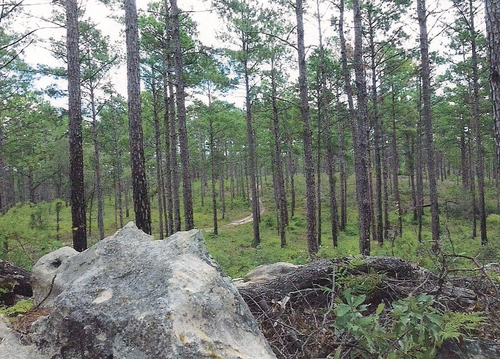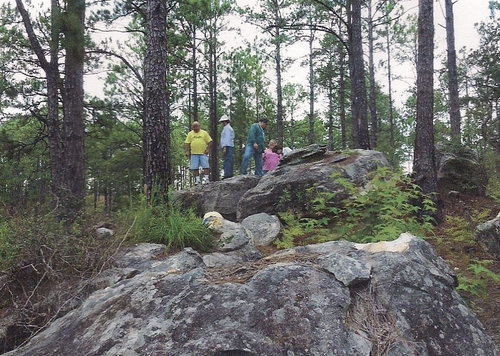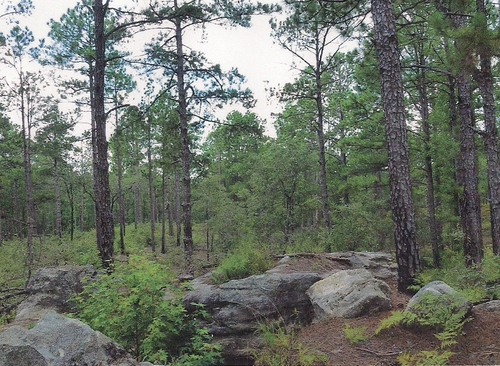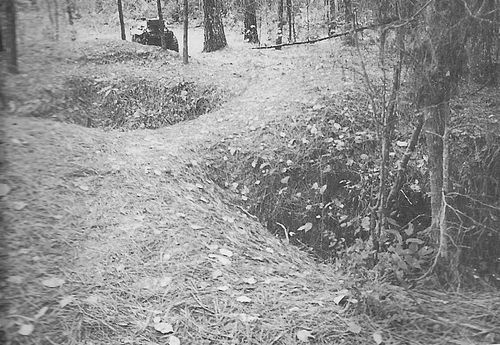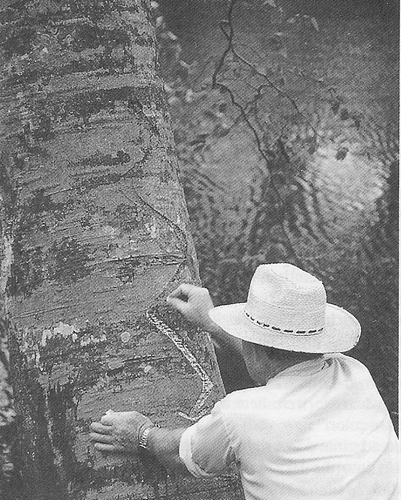.JPG)
The Robber John Murrell and his Famous Hideouts
By Rickey Robertson
During the days of the Neutral Strip that ran along the Sabine River, there were many robbers and outlaws who found refuge here. This Neutral Strip was not owned by the United States nor was it owned by Spain, who was in control of Texas. Due to a border dispute between these two countries, the Neutral Strip was settled on by the governments of these countries till some type agreement could be negotiated. It was a large area, with the eastern boundary being on the eastern side Rio Hondo Bayou down to Kisatchie Bayou, Devil's Swamp, Calcasieu River, and on to the Gulf of Mexico. The western boundary was the Sabine River. By agreement the area was to be un-policed by both countries. There was no law and order to be found so it made a safe haven for these outlaws. One such famous outlaw was John Murrell. John Murrell had a large band of outlaws with him and had 2 large hideouts here in western Louisiana.
John A. Murrell was supposed to have been born in Tennesse around 1800. His father was a Methodist Minister and he learned the Gospel well. But he also learned to steal and rob well also. Murrell began preaching in and around the Neutral Strip in 1825. While he was preaching, he was also establishing and organizing a large band of outlaws. As he traveled around preaching, he established hideouts and headquarters in various locations. He had camps at Midway Station near Fort Jesup and near Los Adais, but his most elaborate headquarters was in a cave hideout near Kisatchie. He also had a secondary set of caves in what is now western Sabine Parish near the little community of Clearwater. Murrell formed his outlaw band into seven clans and he supposedly had eight different banks where his stolen treasures could be hidden. Members of his outlaw clan were identified to each other in several ways. Each had a black locust tree bordered by two Spanish dagger plants in their front yards. Another way to identify each other was a golden medallion they wore around their necks.
John Murrell would go throughout the Neutral Strip peaching and scouting out what types of livestock or valuables the settlers might have. While he was preaching, he would send his men out to rob the homes and farms of the settlers. During this time in American history, there was no cash money, just gold or silver. Stolen gold and silver from the settlers and from the many settlers traveling through the area were hidden in Murrell's hidden banks. Murrell became known as the "Reverend Devil" due to his activities. Besides his robbing and stealing, he dealt in slaves. One thing he tried to accomplish was an uprising by the slaves against their masters. He never succeeded in doing so.
On present day Kisatchie National Forest at Kisatchie, La. John Murrell had his largest hideout. Known as Murrell's Cave, it was a complex cave network in the rock hills and canyons of Kisatchie near Sheard Branch. These caves had rooms that were of various sizes and shapes. There were different rooms for the men to live in , rooms to store the stolen treasures, and rooms to keep the horses and mules. To find the route to these caves, there were many "waybills" to follow. On trees were specific carvings and on rocks were carvings of various types given cryptic directions. Inside the large cave complex, it was noted that along the walls of the caves were names and codes to help the men get safely in and out of the caves. This was also the same type of caves and directions that were known to be around the caves near Clearwater in Sabine Parish.
In around 1942 the US Forest Service decided to dynamite the caves to keep people from getting lost, injured, or even killed as they hunted for "Murrell's Treasure". My Pappaw Craft was working for the Forest Service and he told me some stories of the Kisatchie Caves. He had lived at Kisatchie many years and had been by the caves many times. Pappaw told me of one large room in the caves where there was still a pile of trace chains and leather harness used by Murrells men to pull the wagons and carts loaded with stolen treasure. He said this was still there when the caves were blown up.
My wife and I went to the Murrells Cave area near Clearwater many years ago. Treasure hunter had dug down into the caverns and had destroyed much of this site. It was interesting to note that a spring ran from these caves, and a special entrance where a man could ride a horse into the caves undetected was still there. Water, shelter, and protection were provided by these caves.
John Murrell remains a mystery to this day. Many theories of many types are remembered. One theory was that Murrell was shot and killed by his own gang near Hunts Hill, another that he carried much of his treasure with him to London, England where he died and was buried, another theory was that he secretly left Louisiana and may have went back to Mississippi or Arkansas where he lived out his life, and the last theory was that some of his gang mutinied and turned on him and hanged him near Kisatchie Creek. John Murrell was so careful in the locations of his camps, so careful in gaining the confidence of his men, and so careful in his whole large scale robbery operation that he left few traces of his identity or of what happened to him.
We do know that Murrell's Treasure has never been found. It has been hunted by treasure hunters for years and years. Due to the logging operations, most of the secretly marked trees have been cut and destroyed and the rocks with messages on them also destroyed. We know of one piece of treasure that was found during the days of the virgin timber and turpentine harvests of the early 1900's. A worker building one of the railroad spur trams near Sheard's Branch, using a mules and slip uncovered a solid silver bar around 1924 that was turned in to the company and authorities.
Will Murrell's Treasure ever be found ? Most of the old treasure hunters have passed on and nearly all signs and waybills have been destroyed. But who knows, some hunter, camper, or bird watcher may stumble across all of Murrell's Treasure one day. Was John Murrell a myth? Was he a legend ? Was he killed and buried in the Kisatchie Hills ? Maybe one of these day's we may find the answers to the many questions left us by John Murrell and his treasure of silver and gold. Keep your eyes open, you may stumble across it one day!
